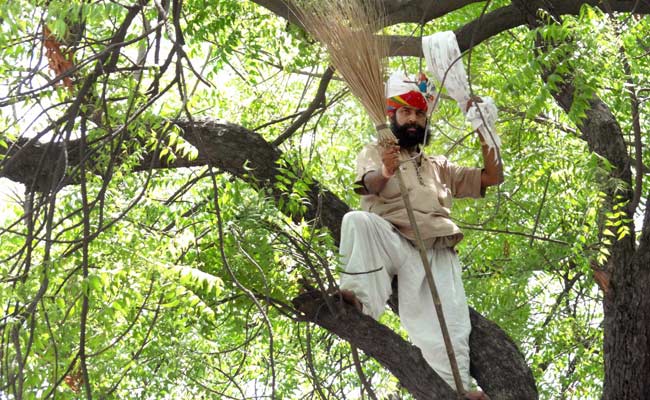by Avinash Pandey
Gajendra Singh, a farmer from Rajasthan hung himself from a tree in the middle of a political rally against the Union government’s indifference to the plight of peasants. His suicide, recorded and broadcast live, has brought the horrors that plague the countryside straight into the discomfort of the homes of everyone with a television and cable connection.
 Gajendra Singh, before he hanged himself at an AAP rally on Wednesday ( April 22, 2015)
Gajendra Singh, before he hanged himself at an AAP rally on Wednesday ( April 22, 2015)
He was not the first farmer to kill himself in India. The republic has turned into a graveyard for farmers for long. He is just one of the more than around 304,000 farmers who have ended their lives owing to the apathy and inaction of different governments. He is not even the first one from his state Rajasthan, which has seen many such suicides, though admittedly not as visibily as the killing fields of Vidarbha in Maharashtra state and Bundelkhand in Uttar Pradesh state; Vidharbha has incidentally crossed the 60,000 mark in recorded cases of farmer suicide.
And, he is not the first farmer to kill himself since the new regime took over in India in the summer of 2014. He is just one of the 8,000 odd farmers who have killed themselves since the Modi government came to power with its Acche Din (good days) promise. Nor is he the first one to end his life in 2015, one of the harshest years for the farmers in recent history. Though official data is hard to come by, even the most conservative estimates peg the numbers at around 1,500 already. A total of 601 of these have come from Maharashtra alone, as per the admission of Maharashtra State Relief and Rehabilitation Minister Eknath Khadse. The Minister, of course, attributed only 3 of them to crop failure; the other 598, you see, had left no suicide note to announcing why exactly they were choosing to kill themselves.
Truncating the lists by falsely attributing farmers’ suicides to reasons unrelated with farming has been one of the favourite tricks of successive governments to hide the worsening agrarian crisis as it ensnares more and more lives. Incidentally, these truncated lists hide even deeper layers of statistical trickery to hide the shame, such as denying farmer status to a huge population engaged in farming. As P. Sainath, a journalist and expert on the agrarian crisis, shows: the Chhattisgarh state recorded 0, 4, and 0 suicides respectively for 2011, 2012, and 2013, despite averaging 1,400 suicides every year from 2001 to 2010. Similar are the figures of Jharkhand, Pondicherry, West Bengal, and several other states.
Did they achieve a miracle to stop farmers from committing suicides overnight? They did not. They just stopped counting them as farmers by picking them out of the category “Self-employed (farming/agriculture)” and putting them in “Self-employed (Others).” Sainath has shown how the miraculous decline in farm suicides is matched by a ridiculous increase in the suicides grouped in the latter category.
Gajendra Singh’s suicide is unique in one respect. His death has put to death the denial of the crisis. It has achieved what more than 3 lakh farmers could not achieve in killing themselves. It has silenced the apologists of the regime, the new one and old one. It has jabbed at the mouths of those with a perennial quest of shoving development down the throats of peasants by usurping their farms and turning them into jungles of concrete. In his death, if not life, Gajendra has given the clinching evidence for the crisis being real and countrywide. It has busted the lies of those who either denied the crisis altogether or talked of pockets of distress. His suicide has turned Rajasthan into the new Vidarbha.
Gajendra Singh’s suicide has also exposed Delhi’s disconnect with those that feed it – the disconnect that plagues the middle classes as well and not just the political leadership drunk on power alone. It has suddenly made the grievances – of those who “dirtied” Delhi with their protests, caused traffic jams, and many other inconveniences – real.
Gajendra, in death, has laid bare the shameless insensitivity of the Media that claims to be the watchdog of the Republic. The fact that the Media has failed to record Gajendra’s, and countless other farmers’, plight should bring shame. And there they were, members of our Press, not even pausing for a moment to film the man who arrived to die. Gajendra’s death has exposed the voyeurs that the people of the Republic have become.
The real message from Gajendra Singh’s death, however, is much more sinister. He has shown that the state that has stopped listening to democratic and peaceful voices of dissent has now stopped even bothering itself with their existence. The lives, and even deaths, of the peasantry do not mean a thing to it.
The problem, though, is what would happen if the peasantry were to return the gesture. India has earned most of its internal insurgencies by similar indifference, hasn’t it? It is just that most of those insurgencies are of communities small in number and localized in particular areas, unlike the Indian peasantry that is neither small nor localized. The Authorities would do better to understand the meaning inherent in his suicide if it wants to survive.
# # #
Mr. Pandey, alias Samar is Programme Coordinator, Right to Food Programme, AHRC. He can be contacted at avinash.pandey@ahrc.asia